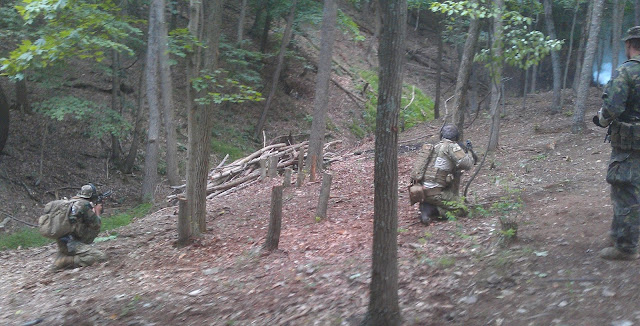Aug 3/4 Training Weekend AAR # 2
AAR: Max Velocity Tactical Combat Rifle/Contact Drills
3-4 Aug 2013
If you are a newcomer to tactical shooting like me, your experience is probably limited to punching paper at 100 yards on a linear range. Or maybe you’ve taken a tactical carbine course where you did a little buddy pair fire and movement, shot behind simulated barriers and killed more paper targets on said range. That’s pretty good stuff for learning gunfighting but it doesn’t realistically train a sure-enough team to react to 360 degree contact.
Max’s course opened my eyes to this reality. His combat rifle course is three-dimensionally realistic in that he uses a 360 degree range in the woods, over rough and uneven terrain with multiple pop-up targets to the front, left and right. There aren’t many places a civvie can get this type of training. Max uses this range and his experience to effectively train the student in react-to-contact and fire and movement tactics.
Day 1
Day 1 starts out on the shorter range at the individual level with react to contact drills. Max uses a straightforward, no-nonsense teaching style to convey the importance of reacting, taking cover and then returning accurate fire. After starting with contact front, the student moves on to running this drill with contact left and contact right.
The training day smoothly progresses to fire and movement tactics with buddy pairs and four-man teams. Here, the student learns movement in bounds with one man delivering fire support while the other man either moves to break contact or advance on the position. This gets real fun at the four-man team level where buddy pairs peel from left or right contact, even working on getting back on line as the attack angle becomes acute.
While max doesn’t come across as a drill instructor, he certainly reinforces the need to communicate during fire and movement. By the end of the day, when the moving team member heard “STOPPAGE!”, you better bet he learned to hit the dirt mid-stride and find cover.
Day 2
Day 2 takes off where the first training day ends. With sound tactics learned, drills are ran on a longer, wider and deeper range to drive the lessons home. On this range, contact comes during a “jungle walk” type patrol. Humping your gear up a slight hill as you advance to the contact area elevates your heart rate and respiratory cycle, adding another element of realism when fire and movement begins.
With the buddy and four-man teams, the jungle walk is where the rubber meets the road. It takes communication to relay target location – at times multiple targets in unknown locations. You quickly learn to get your tail to cover, locate and engage the “enemy” so your team can get off the X. You really start to appreciate the idea of frequent practice with your team so you can learn their individual habits during movement and communication. Wow, good stuff.
After an instructional period, the day was topped off with an eight-man team bunker assault. A four-man team remained in fire support while the second team flanked and cleared the bunker. Awesome!
Takeaways
Build a team and train, train, train. You can’t do it alone.
Communicate. Clearly. Target location, “move”, “moving”, “get on line”, etc.
No movement without fire support (and make sure your rifle fires before telling your buddy to move)
Summary
This course offers practical training in the application of contact and fire and movement tactics. The skills learned are simply something you cannot acquire by shooting paper targets on a linear range. It certainly helps to be trained by someone who’s been there and done it. We had tactical newbies and veterans alike and they all seemed to learn new skills and re-hone old ones. If you have thoughts of training with your pals as a team, you gotta get them to this course. I’m looking forward to advanced classes in the near future.
Brian from Georgia




